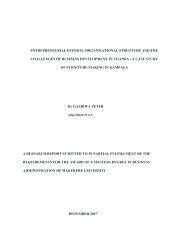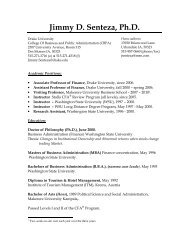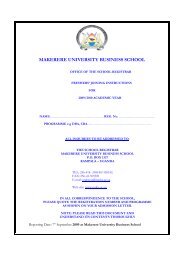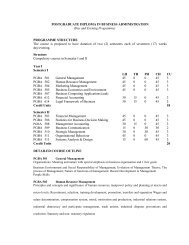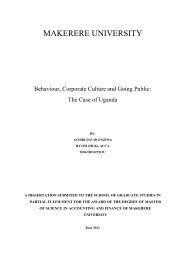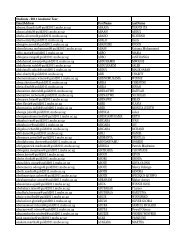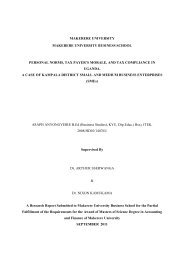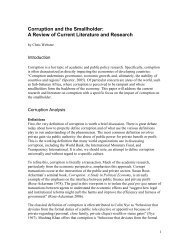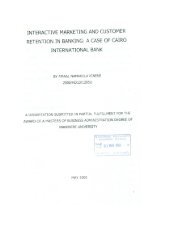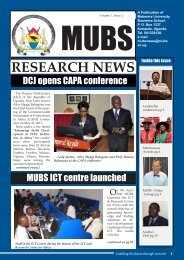13th Annual International Management Conference Proceeding
13th Annual International Management Conference Proceeding
13th Annual International Management Conference Proceeding
You also want an ePaper? Increase the reach of your titles
YUMPU automatically turns print PDFs into web optimized ePapers that Google loves.
2.0 Methodology of the Study<br />
Data Collection and Research Design<br />
The survey focused on collection of data for estimating the empirical banana production function. In this<br />
survey, a self-administered questionnaire was orally administered on 200 respondents from the sub-county.<br />
Data on labor, land, capital, culture, land tenure systems and markets were collected. The study followed a<br />
cross sectional survey design, exploratory in nature. Both quantitative and qualitative techniques were used<br />
for analysis. The Qualitative technique was chosen because the researcher wanted to probe for more<br />
information regarding the social and cultural dimensions of agricultural production.<br />
Data Collection and Research design<br />
Data and its sources<br />
Primary data was the major source. This was collected from visits and surveys made in the district so as to<br />
investigate the factors that determine agricultural output in the district. Secondary data was however used to<br />
supplement the primary data. This was collected from annual reports at the district and other relevant<br />
documents.<br />
Study Population, Sample size and Sampling technique<br />
Nyakyera Sub County has a population of 30,509 people distributed in 7 parishes. It also has 6,698<br />
households. This constituted the study population. A sample of 4 parishes was purposively selected. There<br />
are 957 households on average in each Parish. Fifty households were selected from each parish using<br />
systematic random sampling. According to Carl et al (1995), the systematic random sampling technique is<br />
widely used because of its simplicity in application. The researcher skips a certain number of the population<br />
in selecting the sample.<br />
SI=PS/SS<br />
Where; SI=Skip Interval, PS=Population Size, SS=Sample Size<br />
Data Collection Techniques<br />
Questionnaires were designed for the 200 heads of households. The questionnaires were arranged into<br />
sections or themes such as, land, labour, technology, capital, division of labour and all other factors as<br />
stipulated in the literature. Respondents were asked to give their views on each of these factors.<br />
The results obtained from the questionnaire were tallied and tabulated to indicate the importance of each<br />
factor in explaining agricultural output. Both quantitave and qualitative techniques were used for analysis.<br />
Graphs, tables and charts were used to present the findings in a more interpretable form. Focus group<br />
discussions were also held with local communities and local council leaders at various levels to investigate<br />
factors explaining agricultural output in the sub-county.<br />
Data Preparation and Analysis<br />
Data from the field was edited to ensure accuracy, consistency, uniformity and completeness. Open-ended<br />
responses were coded where necessary. Using SPSS (statistical package for social sciences) and STATA, data<br />
was summarized into descriptive statistics. A Cobb-Douglas model specification was formulated and a<br />
Poisson regression analysis was performed to establish the degree to which Land, Labour, Capital and<br />
manure application affect Banana Production.<br />
The production Function<br />
The production function describes the technical relationship that transforms inputs into output (Debertin,<br />
1992) and for this case transformation of labour, capital, land and manure into banana output. Martian<br />
(1918) quotes that a series of whole farm production function studies have been conducted. And so,<br />
William et al (1977) used the production function to estimate the contribution to total output of not only<br />
the quantity of traditional inputs (land, labour, fertilizers) but also the quality of certain inputs particularly<br />
irrigation, technology, environmental factors, soil type, rainfall etc and infrastructure (transportation,<br />
markets etc). In this study, total value of banana yield was considered to depend on farm labour supply,<br />
capital, land and manure use was used as a Dummy variable.<br />
73



